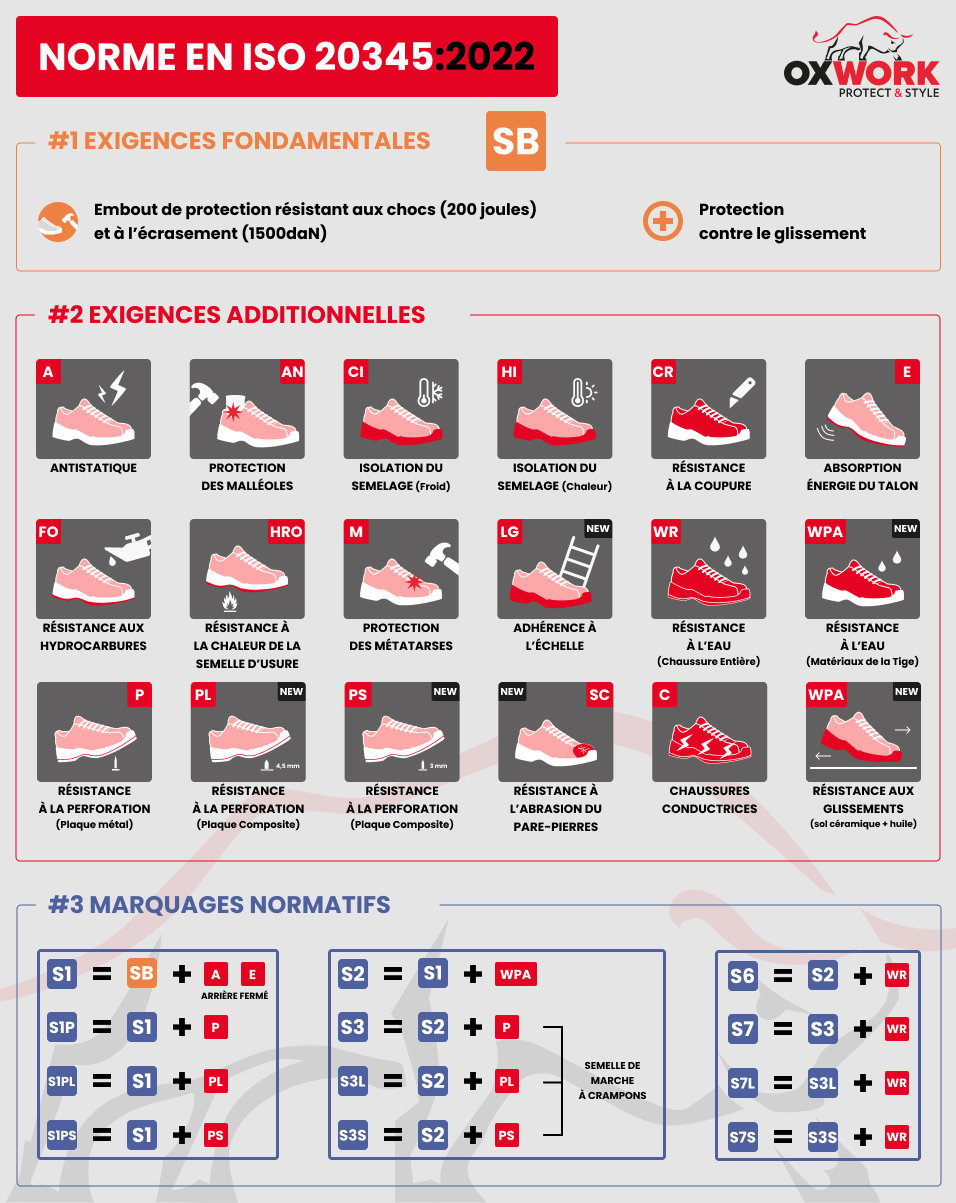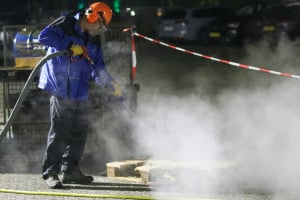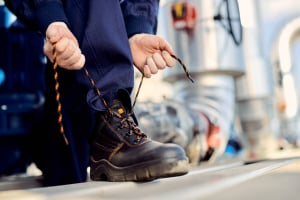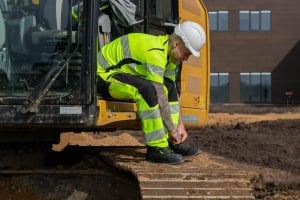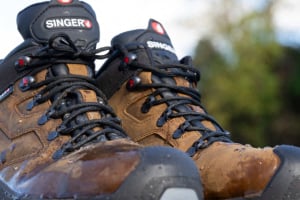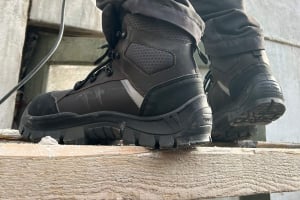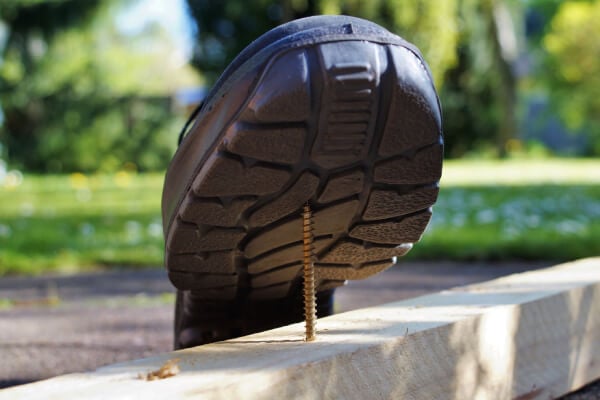
What is the EN ISO 20345 standard for safety footwear?
The EN ISO 20345 standard is a European regulation which defines the basic criteria for the design and manufacture of safety shoes. To better understand this standard and its implications for workplace safety, it is essential to become familiar with its different requirements and meanings.
As part of worker protection, several EN ISO standards have been developed to regulate the requirements of footwear intended for different work environments. Each of them is distinguished by the levels of protection offered.
| Standard | Type of Shoes | Protection | Usage |
| EN ISO 20345 | Safety shoes | Protective tip resistant to 200 joules | Work environments presenting significant risks (shocks, perforations, slips, burns, etc.) |
| EN ISO 20346 | Protective shoes | Protective tip resistant to 100 joules | Working environments with lower risks |
| EN ISO 20347 | Work shoes | No protective tip | Work environments where the risk of injury is minimal, with an emphasis on user comfort |
What are the requirements of the EN ISO 20345 Safety Footwear Standard?
The EN ISO 20345 standard sets out a number of essential requirements that safety footwear must meet to ensure adequate protection for workers. These requirements concern various parts of the shoe, including the upper, toe cap, insole and outsole.
Stem
The upper of the shoe, which is the upper part that wraps the foot, must be designed to provide optimal protection. It must be water resistant (at least for 60 minutes if the WRU marking is present), and puncture resistant.
Protective tip
The most important element of safety shoes is the protective toe cap. This tip, generally made of steel, aluminum or composites, must withstand a shock of at least 200 joules. This is equivalent to a mass of 20 kg falling from a height of one meter. In addition, after the impact, the protective toe must guarantee a safety space of at least 14 mm for the toes.
Insole
The insole must provide adequate comfort and support for the foot. In some safety shoes or safety trainers, the insole may also be designed to resist puncture.
Outsole
The outsole of safety shoes has several functions. It must provide good grip to prevent slips and falls. It must also be resistant to abrasion and hydrocarbons. In addition, it must have a certain resistance to heat and be insulating against heat and cold.
It should be noted that these requirements are the minimum to be respected for shoes to be classified as "safety shoes" according to the EN ISO 20345 standard. Other requirements may be added depending on the specifics of the workplace.
What are the additional requirements of the EN ISO 20345 standard for safety footwear?
In addition to the basic requirements that we have just seen, the EN ISO 20345 standard also specifies several additional requirements for safety footwear. These additional requirements are indicated by specific codes. Here is a table explaining these codes and their principles:
| Code | Requirement |
|---|---|
| A | Antistatic: The shoe dissipates electrostatic charges to prevent the risk of electrostatic sparks. |
| AN | Protection of the malleolus: The shoe offers additional protection against impacts at the level of the malleolus. |
| CI | Insulation of the sole against the cold: The sole of the shoe provides insulation against the cold. |
| CR | Cut resistance: The shoe offers cut resistance, to protect the user against sharp objects. |
| E | Heel energy absorption capacity: The heel of the shoe has the ability to absorb energy to minimize impact when walking or running. td> |
| FO | Oil-resistant outsole: The outsole is oil-resistant, which is particularly useful in industrial environments. |
| HI | Heat insulation of the sole: The sole of the shoe provides insulation against heat. |
| HRO | Heat resistance of the outsole: The outsole is resistant to contact heat up to 300°C. |
| M | Metatarsal protection: The shoe offers additional protection against impacts at the metatarsal level. |
| P | Puncture resistance: The shoe provides protection against punctures from sharp objects. |
| WR | Resistance to water penetration of the entire shoe: The shoe is waterproof, which is useful in wet or muddy environments. |
| WRU | Resistant to water penetration and absorption of upper materials: The upper of the shoe resists water penetration and absorption. |
What is the meaning of the SBP, S1, S1P, S2 and S3 markings on safety shoes?
The SBP, S1, S1P, S2 and S3 markings indicate the level of protection that safety footwear offers according to EN ISO 20345. Each marking represents a specific set of requirements that the shoes must respect. Here is the meaning of each marking:
SBP
- Toe protection: withstands an impact force of 200 joules and a compression force of 15 kN
- Antistatic properties
- Energy absorption in the heel area
- Perforation resistance of the sole: resists a penetration force of 1100 Newtons
S1
- Includes all SBP standard requirements
- Closed back of the shoe
- Water resistance for a limited time
- Heat resistance of the sole up to 150°C
S1P
- Includes all requirements of the S1 standard
- Perforation resistance of the sole: resists a penetration force of 1100 Newtons
S2
- Includes all requirements of the S1 standard
- Resistance of the upper to water penetration and absorption
S3
- Includes all requirements of the S2 standard
- Perforation resistance of the sole: resists a penetration force of 1100 Newtons
- Sole with reliefs (studs)
What do the SRA, SRB and SRC standards mean?
These standards refer to the grip of the sole.
SRA and SRB test grip on ceramic and steel floors respectively, while SRC indicates the shoe has passed both the SRA and SRB tests.
To comply with the fundamental standard (SB), a safety shoe must have an SRA or SRB marking. Safety shoes with a so-called traditional sole are required to comply with the SRA sliding standards or SRB at least.
Which safety shoes to choose?
The choice of safety footwear must be guided by the nature of the work and the associated risks. Workplace risk analysis will help determine the level of protection required.
To find out how to choose safety shoes that suit your needs, consult our article on "how to choose your safety shoes?"
Standard EN ISO 20345:2011
This version of EN ISO 20345 introduces new requirements for safety footwear, including more rigorous testing for puncture resistance and thermal insulation strong>.

EN ISO 20345:2022 standard (new standard)
The latest version of EN ISO 20345 adds new requirements for protection against electrical risks, which is particularly relevant for workers in the electrical industry.
